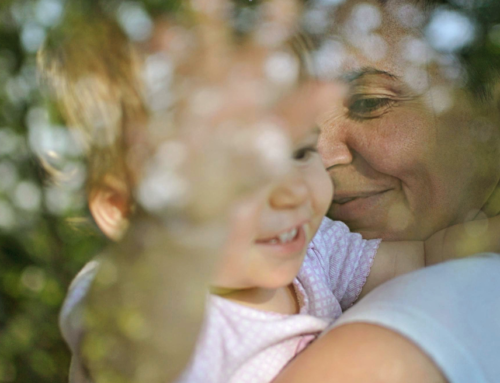The stress response
40,000 years ago, two cave people walked out of their cave. It was summer and the sun was shining. One of the cave people thought to themselves “What a lovely day…I think I will go and eat some berries and have a swim, and later I might lie and watch the clouds and maybe have a sleep on the river bank”. The other thought “It’s a lovely day, but who knows what will happen tomorrow…I better use this opportunity to sharpen my spears and fortify my cave a bit”. Now, which of these two do you think survived longer and passed on their genes to you?
Your nervous system is basically a survival system. The tendency to be suspicious and wary (is that rustling in the bushes a bunny rabbit or could it be a sabre-tooth tiger?) has been genetically selected for, and is now part of you. A part of your brain called the amygdala is the “fear centre” of your brain. When it activates, you perceive things as threats, even if they are just bunny rabbits playing in the bushes.
Faced with a life-threatening situation such as a snake, the amygdala becomes active. In response, your body undergoes a number of rapid changes. Your adrenal glands dump adrenaline into your blood stream to prepare you for action. As a result, your heart rate increases and your blood pressure goes up. Your respiration increases to maximise oxygen flow to the muscles. You release cortisol, a stress hormone that comes in handy if you get injured. Your blood platelets thicken, for a similar reason. The cortical areas of your brain switch off in favour of deeper, older parts of your brain (the so-called reptilian brain – so that paradoxically it becomes literally snake-on-snake). Your attention fixates on the threat and you lose sight of the lovely bush walk you were on. Your amygdala fires up and you become aggressive and reactive. And you are likely to respond with avoidance, anger or freezing up. This is why it gets called the ‘fight-or-flight response’. This response turns on in about a 100th of a second, and you still have elevated levels of adrenaline in your bloodstream 90 minutes later, presumably in case there are other snakes (or tigers) around.
But imagine that as you are walking along you see what looks like a snake out of the corner of your eye. In a flash your nervous system triggers a fight/flight response. But then you realise that actually it is just a piece of rope coiled up, that you misperceived as a snake. Suddenly you are in a fight/flight response (also called a ‘stress response’) but there is no actual threat. And the elevated heart rate and blood pressure, adrenaline, cortisol etc. is just causing unnecessary wear and tear on your body. The fixating of your attention and your avoidance/aggression reaction is suddenly totally inappropriate.
And if you think about it, we all have a number of ‘ropes’ in our lives. That is, there are things that we misperceive as life-or-death situations and react to with stress responses, when actually there is no threat. For some people this is public speaking. For others it is difficult conversations, job interviews, or exams. There is no shortage of ‘ropes’.
The irony is that when we are in the grip of a stress response in the face of an innocuous situation like an exam, we become unable to properly focus on what needs to be done to get there. We all know the experience of worrying about an upcoming exam so that we can’t focus on the revision and exam preparation that we need to do to perform well. Or the experience of our mouth going dry and voice high when we need to speak in public. Which of course then tends to make us even more anxious, increasing the stress response further.
Research has shown that stress can lead to anxiety and depression if it is not dealt with properly. It also lowers our immune system, rendering us vulnerable to illness, and even speeds up the aging of our cells. We therefore need to manage it properly.
How mindfulness can help
This whole process begins with first noticing that we are in a stress response. We can do this by becoming attuned to the pattern of physical sensations that accompanies our fight/flight reactivity, or the changes to our breathing. The more aware of our body we are, the earlier we can catch these sensations. And the earlier we realise we are reacting, the earlier we can do something different to make sure that we don’t end up in an overwhelming, full-blown reaction, where it is much harder to do anything about it. Or perhaps we notice the stress reaction first in our mind – becoming present to our thoughts racing or our attention fixating on some apparent ‘threat’. Or for some people, it is the reaction that gets noticed first – the avoidance and procrastination, or the aggression and frustration.
However it is noticed, the recognition of these stress response indicators is a very good thing. It can be tempting to judge ourselves when we find ourselves in such a reaction, but if you think about it, this judgment just takes us further into reactivity and further from being present. Self-criticism activates the amygdala, making the situation worse. The best thing we can do when we catch ourselves reacting is to acknowledge that it has happened and then gently return our attention to our body or breath, or to something else that is happening in the senses. Misperception can only ever happen in the mind, and bringing our attention back to the senses naturally disconnects us from it. We can then see the situation more clearly for what it is, and can therefore respond appropriately.
This is why mindfulness practice begins with the body and the breath. And it is also why we need to spend some time each day deliberately practicing noticing when our attention gets caught up in Default Mode and bringing it back. Meditation is like going to training sessions for a sport: we practice the basic ‘skills’ in low-stakes situations so that we can then access them more easily ‘in the game’.
Take Ten Breaths
This is a simple exercise to centre yourself, and connect with your environment. Practise it throughout the day, especially any time you find yourself getting caught up in your thoughts and feelings.
- Take ten slow, deep breaths. Focus on breathing out as slowly as possible, until the lungs are completely empty – and then allow them to refill by themselves.
- Notice the sensations of your lungs emptying. Notice them refilling. Notice your ribcage rising and falling. Notice the gentle rise and fall of your shoulders.
- See if you can let your thoughts come and go, as if they are just passing cars, driving past outside your house.
- Finally, notice your breathing, and your body at the same time – your arms, legs, head, neck, shoulders. And also look around the room and notice what you can see, and hear.
Explore mindfulness and mindful self-compassion practices during week long retreat on a beautiful island of Koh Phangan, Thailand with Dr Alla Demutska and Dr Richard Chambers (31 August – 8 September). Take time off to focus on improving your quality of life and to slow down, build your resilience and connect with yourself. You will also learn powerful tools that will help you focus, be more self-aware and improve your life long after the retreat has ended.
For more information go to http://www.tworiversretreat.com/
You can also get help by accessing psychology sessions in Kundalini house. Please call Insight Psychology Centre 0476 131 281
Suggestions outlined in this article are not a substitute for therapy.
If this is an emergency, please dial 000.
If you need to speak to someone urgently, please contact your local Crisis Assessment and Treatment Team (CATT) http://www.health.vic.gov.au/mentalhealthservices/adult/








Leave A Comment